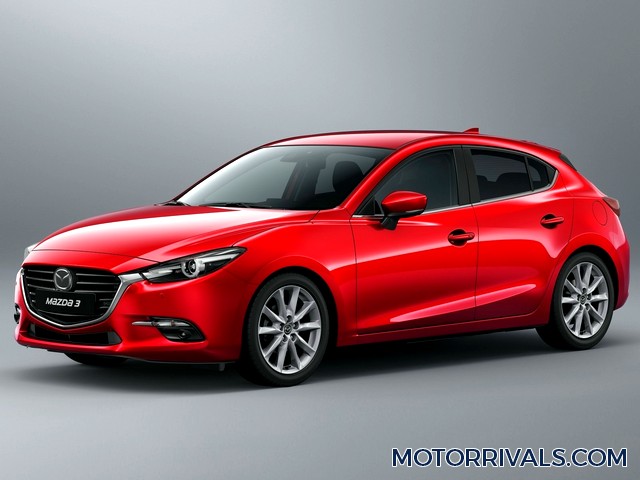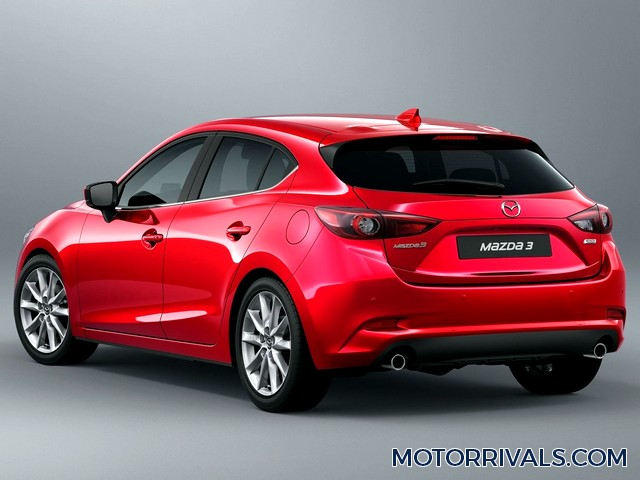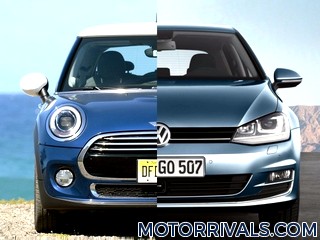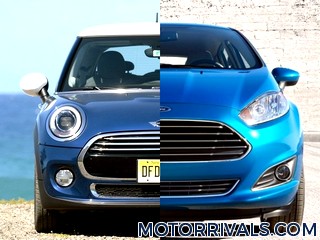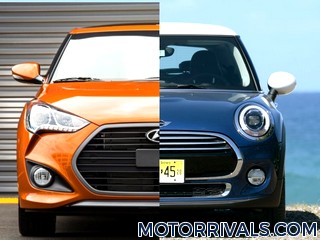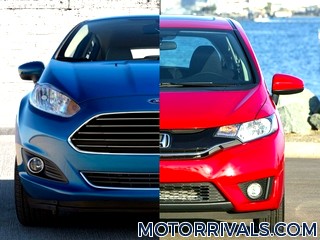2017 Mazda 3 5-Door vs 2017 Volkswagen Golf 4 Door
Mazda Press Release Highlights
Building on its award-winning predecessor, developers of the all-new Mazda 3 set out to do no less than come up with a car that actually interacts with its owner on several levels. On the surface, it's a top quality means of transport, delivering an unmatched combination of performance, fuel efficiency and functionality in a package that's as safe and practical as it is stunning. Here it follows in the footprints of its new generation forerunners: the Mazda CX-5, a compact SUV that drives like a car, and the new Mazda 6, which more recently took the mid-sized class by storm.
Powertrain
The new Mazda 3 also comes with the SKYACTIV-G 2.0 in two versions. The high-power version churns out 121kW / 165PS at 6,000rpm and 210Nm at 4,000rpm. It thrusts the compact from a standstill to 100km/h in 8.2 seconds with a terminal speed of 210km/h. At 5.8l/100km and 135g/km, fuel consumption and CO2 emissions are very respectable for such performance. The standard power SKYACTIV-G 2.0, meanwhile, puts out 88kW / 120PS at 6,000rpm and, like its sibling, 210Nm at 4,000rpm. Available for both body styles with either the SKYACTIV-Drive automatic or SKYACTIV-MT manual transmission, this economical option combines first-rate fuel efficiency and CO2 emissions - 5.1l/100 km and 119g/km (manual) and 5.6l/100 km and 128g/km (automatic) - with respective sprint times of 8.8 and 10.3 seconds, topping out at 198km/h.The SKYACTIV-D clean diesel also uses extreme compression and lightweight design as the basis for powerful yet remarkably fuel-efficient engines. Unusually for a diesel, the 380Nm of maximum torque at 1,800rpm and 110kW / 150PS at 4,500rpm offers satisfying pull from a standstill through to its 5,500rpm redline. The new Mazda 3 takes only 8.0 seconds to reach 100km/h with a manual and 9.7 seconds for the automatic (hatchback only), with respective top speeds of 213km/h and 201km/h. And that with fuel economy and CO2 emissions of 3.9l/100km and 104g/km (sedan with manual), and 4.8l/100 km and 127g/km (hatchback with automatic).
Chassis
Mazda tuned the new Mazda 3's SKYACTIV-Chassis to respond more faithfully than ever to driver intentions. High-tensile steel (780MPa) was used for the lower suspension arms on the front MacPherson struts and rear multi-link trailing arms. This not only makes the suspension lighter, but also smoothens load transfers and with it changes in cornering g-forces. The positioning of rear suspension links and hardness of the bushings, meanwhile, improves the lateral grip of the rear tires. By moving the trailing arm position forward, the dampers can better absorb road influences.The electric power assist steering's lower gear ratio - 14:1 versus 16.2:1 on the current model - means less steering wheel movement, enhancing agility and helping avoid driver fatigue, particularly on winding roads and in the city. The system is smaller, lighter and more energy efficient, too. The brakes get smaller cylinders, retuned boosters and reduced pedal play to suppress motion resistance. These improve brake control, responsiveness and fuel economy. In combination with new high-grip tires, they're particularly effective on wet roads: Stopping distances are considerably shorter than the current model and among the best in the segment.
Technology
The in-vehicle system expands on features already available in Mazdas, like Bluetooth®, email, SMS and navigation, adding a whole new scale of connected convenience. Using a smartphone connected to the Mazda 3 system via Bluetooth® or USB, Mazda 3 occupants have safe and easy real-time access via the 7-inch display to infotainment services from Aha. It offers a wide and growing range of mobile infotainment content and social media services, including tens of thousands of internet radio stations, Twitter and Facebook feeds, news, audio books and more.Aha is a cloud-based automotive grade internet connectivity platform. Available for the first time at Mazda with the all-new Mazda 3, Aha is designed to provide a single integration point bringing a wide range of free web-based infotainment content safely into the vehicle. Aha lets the user access and organize their favorite web content on their phone, then seamlessly integrates the experience in their car. Developed together with BOSE® especially for the new Mazda 3, the new 9-speaker BOSE® premium sound system features the latest in playback technology and, of course, plenty of power.
Safety
i-ACTIVSENSE is Mazda's term for its advanced range of sensor-based and radar-supported safety technology. The radar-based Rear Vehicle Monitoring system (RVM), for example, tells the driver when vehicles are approaching the new Mazda 3 from behind in adjacent lanes - including the blind spots - by activating an LED in the corresponding side mirror. The Lane Departure Warning System (LDWS), meanwhile, watches the lane markings at 65km/h and higher, alerting the driver with audible (rumble strip sound) and visual warnings should it detect unplanned lane changes. And the Distance Recognition Support System (DRSS) looks well ahead of the car, calculating and displaying the proximity and catch-up time to preceding vehicles at 30-200km/h. The Adaptive Front-lighting System (AFS) predicts the shape of the curve ahead based on steering input and speed, turning the headlamps in the right direction. Hill Launch Assist (HLA) is another helpful system that maintains brake pressure to prevent rolling during hill starts. i-ACTIVSENSE pre-crash safety technology warn the driver of potential danger. However, as names like Mazda Radar Cruise Control (MRCC) and Smart Brake Support (SBS) suggest, they'll also take evasive action if necessary to avoid an accident or limit the damage. Naturally, the new Mazda 3 also has standard ABS with electronic brakeforce distribution (EBD) and brake assist (EBA) as well as dynamic stability control (DSC) and traction control (TCS).Volkswagen Press Release Highlights
This new-generation Golf has grown in size yet dropped in weight by up to 79 pounds (depending on model), despite a plethora of new and upscale features. The new generation introduces Volkswagen’s versatile MQB (modular transverse matrix) vehicle platform to the U.S. market—a significant step in standardizing, simplifying, and improving the design and creation of products across the entire Volkswagen Group portfolio. The MQB architecture allows for a more cab-backward design, which gives the new Golf a more upscale appearance while retaining classic design cues from the Mk 1 and Mk 4 Golf models.
The new Golf is better equipped than its predecessor, no matter the trim level. The limited-availability entry Golf Launch Edition two-door with manual transmission starts at $17,995 (plus $820 destination and handling) and adds the following over the outgoing Golf 2.5L: a turbocharged and direct-injection four cylinder as the base engine, along with a standard 5.8-inch touchscreen infotainment system, Bluetooth® connectivity, a Media Device Interface (MDI) with iPod® integration, and SiriusXM® Satellite Radio. The Automatic Post-Collision Braking System (APCBS) is standard on all Golf models, while available new comfort and convenience features include the Fender® Premium Audio System and Climatronic® automatic air conditioning. Fans of Volkswagen’s TDI Clean Diesel engines will be thrilled that the price of the base TDI model has been reduced by more than the $3,000 compared with the previous-generation Golf TDI model.
At launch, Volkswagen will also offer the Golf Sport model. About 650 of these SE four-door models will be built, equipped with the six-speed automatic transmission. Offered in either Pure White or Platinum Gray, the Sport model is visually enhanced with a striking bodykit that includes a front lip spoiler, side skirts, a rear valence, a larger rear spoiler, and chrome exhaust tips. Pricing starts at $26,930, plus $820 destination and handling.





